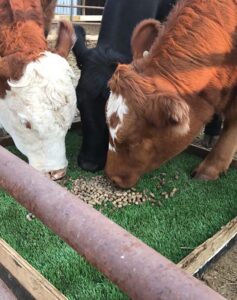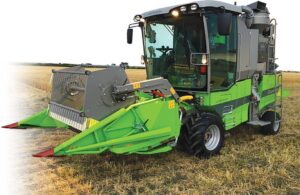Saskatchewan Bulletin
Investments in canola utilization research
Canola meal utilization research important to crop and livestock producers
SaskCanola strategically invests in various areas of canola research, including canola utilization – which benefits both crop and livestock producers. “Research funded by Saskatchewan canola growers has demonstrated the benefit of canola meal in the diets of dairy cattle,” says Dale Leftwich, Policy Manager with SaskCanola. “This has elevated canola meal from a by-product to a highly valued feed component used in dairy rations all over the world. New research on feed rations for beef cattle not only have tremendous benefits here in Saskatchewan, but it could be the foundation for new export markets.”
A recent project led by University of Saskatchewan researcher Gregory Penner compared protein source and frequency of supplementation on forage intake, competitive feeding interactions, and nutrient utilization for beef cattle fed low-quality forage. “There are quite a few situations in Western Canada where protein may be limiting for diets of beef cattle, particularly for growing steers and replacement heifers,” explains Penner. “There are points in time in grazing systems when plants are senescent or mature, or when grazing crop residues where protein supplementation will be beneficial. The results of our study, which were very consistent with what had been reported in the literature, showed that protein supplementation increased growth performance and forage intake for heifers fed protein-deficient forage.”
In the study, yearling heifers were fed either canola meal or distillers’ grains, daily or every second day, as protein supplements to low-quality forage diets. The growth performance responses in the study were remarkable, with gains that were more than 0.8 pounds per day over the control, and really shows that control cattle were limited on protein to meet their daily requirements. The study also showed feeding double the amount of protein supplements every second day was sufficient, saving producers time, labour and machinery costs.
“From a diet cost perspective and how it pencils in, canola meal really shines,” adds Penner. “Although performance results of feeding canola meal or distillers’ grains were similar, the high quality canola protein was cheaper and more cost competitive when priced on a per unit protein basis. Canola meal is also a clean feed with few concerns, compared to feeds like grain screenings or distillers’ grains where mycotoxins and other factors can be a problem. The results show that utilizing products
like canola meal can provide a supplement solution to a feeding challenge for livestock producers utilizing stockpiled grazing and crop residues.”

Penner has a new Ag Demonstration of Practices and Technologies (ADOPT) project underway in collaboration with the Saskatchewan Stock Growers Association (SSGA), and funded by Saskatchewan Cattlemen’s Association and the Saskatchewan Ministry of Agriculture to demonstrate the benefits of canola protein supplementation to a commercial operation. The demonstrations will be set up at two farms to compare a straw/chaff grazing system with a stockpiled forage/mature forage stand system.
“We’re finalizing the details and expect the trials to run over 60 days in October and November,” says Chad MacPherson, SSGA general manager. “Each farm will provide 50 replacement heifers, with 25 control animals on grazing and the other 25 animals on grazing plus receiving canola pellet supplementation at a rate of 2.5 pounds per animal every second day.” Body weights at the start and end will be measured as well as an estimate of forage intake and pellet delivery, with results expected by the end of the year.
With the increasing crushing capacity over the next couple of years in Saskatchewan, there will be additional local canola meal supply available. “However, in talking to crushers, although canola meal products are available, there are access issues for producers,” says MacPherson. “There are currently some logistical issues as crushers don’t sell direct to farm. They sell to brokers and then to feed mills. We are trying to raise awareness of the viability, benefits and cost competitiveness of canola meal, and hopefully someone will step up to commercialize canola meal pellets for this industry. It’s great to see this symbiotic relationship between the crop and livestock sector for this local canola opportunity.”
SaskCanola awards Morris Sebulsky Endowment Fund to eight Agri-ARM sites in Saskatchewan
Morris Sebulsky was a respected farmer from east-central Saskatchewan and a professor of agricultural engineering at the University of Saskatchewan. He was passionate about agricultural research, demonstration and application. He made a generous bequest of over $2.8 million to the University of Saskatchewan, the Saskatchewan 4-H Foundation, neighbouring towns and rural municipalities, and four commissions. SaskCanola has matched the funds received from the Sebulsky estate to invest in equipment and demonstration trials at the eight Agri-ARM sites across Saskatchewan.
Agri-ARM sites are non-profit producer- led applied research and demonstration organizations committed to supporting growers by promoting profitable and sustainable agriculture through facilitating agronomic research and technology transfer activities for the benefit of the agricultural community. Eight Agri-ARM sites are strategically located across Saskatchewan’s main crop production areas to cover various soil climatic zones.
SaskCanola acknowledges and values the critical role of the Agri-ARM sites to our farming community and the comprehensive support and educational opportunities these sites provide to producers in the province. To further advance the capacity to conduct regional research relevant to local farmers and to address gaps that may exist through other funding opportunities, SaskCanola awarded investments from the Morris Sebulsky Endowment Fund over each of the last three years to the Agri-ARM sites.
“Primarily operating through project- based funding, it can be very difficult for Agri-ARM organizations to purchase or replace all of the equipment that is required to run our programs. The funds ultimately allow us to focus resources on our applied research and demonstration programs, while taking a great burden off of our capital spending plans,” says Danny Petty, executive manager at Indian Head Agricultural Research Foundation (IHARF).
Research continues to be a cornerstone of SaskCanola’s programming. About 40 per cent of levy dollars are invested in research initiatives to help growers and move the industry forward. SaskCanola is committed to supporting local research and extension activities relevant to growers’ regional conditions and farming practices.






